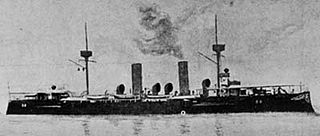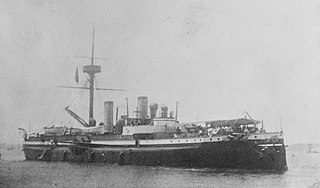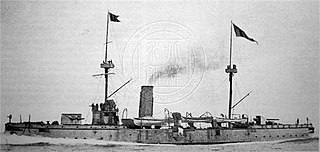 W
WChaoyong was a cruiser built for the Imperial Chinese Navy. She was built by Charles Mitchell & Company in Newcastle Upon Tyne, England, from a design by Sir George Wightwick Rendel which had already been used on the Chilean Navy vessel Arturo Prat. Two ships were ordered by the Chinese, Chaoyong and Yangwei. Both would serve together throughout their careers, assigned to the Beiyang Fleet and based in Taku during the summer, and Chemulpo, Korea, in the winter.
 W
WHai Chi was a Hai Chi-class protected cruiser of the Imperial Chinese Navy. She was at the time the largest warship in Imperial China with a displacement of 4,300 tons and was armed with two 8-inch (203 mm) guns and a top speed of 24 knots. She subsequently served in the Republic of China Navy, before being scuttled in 1937. The hull of the vessel was raised in 1960 and subsequently broken up.
 W
WHai Tien was the second ship of the Hai Chi class of protected cruisers and one of the last built for the Manchu Qing Dynasty.
 W
WHai Yung was a protected cruiser of the Chinese Navy. Hai Yung was one of a class of three ships built in Germany for the Chinese after the losses of the First Sino-Japanese War. The ship was a small protected cruiser with quick-firing guns, a departure from the prewar Chinese navy's emphasis on heavy but slow-firing weapons for its cruisers. Hai Yung resembled the British protected cruisers of the Apollo class and Italian Regioni class, and may have been modeled on the similar Dutch Gelderland-class cruisers. Germany itself would increase the number of similar ships for its own navy starting with the Gazelle class and its faster successors up until World War I.
 W
WHeien , originally known as Pingyuan, built by the Mawei Navy Yard near Foochow (Fuzhou), was an ironclad coastal battleship serving with the Imperial Chinese Beiyang Fleet and later the Imperial Japanese Navy. Previous transliterations of its Chinese name include Ping Yuen and Ping Yuan, also of its Japanese name Heiyen.
 W
WJingyuan was a cruiser built for the Imperial Chinese Navy. She was built by Armstrong Whitworth in Elswick, England. She was one of two Zhiyuen-class protected cruisers built, alongside her sister ship Zhiyuen. Jingyuan was armed with a smaller number of large sized naval guns, as opposed to later ships of this type which carried a larger number of smaller guns. This was because the medium-calibre quick-firing gun had yet to be introduced, thus a warship's firepower at the time was largely a function of individual shell weight rather than volume of fire.
 W
WJingyuan was an armored cruiser in the late Qing Dynasty Beiyang Fleet. Her sister ship was Laiyuan.
 W
WJiyuan, was a protected cruiser of the Imperial Chinese Navy, assigned to the Beiyang Fleet. She was constructed in Germany as China lacked the industrial facilities needed to build them at the time. Jiyuan was originally intended to be the third ironclad battleship of the Dingyuan class, but was reduced in size due to funding issues. Upon completion, she was prevented from sailing to China during the Sino-French War.
 W
WLaiyuan, also known as Lai Yuen, was an armored cruiser in the late Qing Dynasty Beiyang Fleet. Its sister ship was Jingyuan.
 W
WYangwei was a cruiser built for the Imperial Chinese Navy. She was built by Charles Mitchell & Company in Newcastle Upon Tyne, England, from a design by Sir George Wightwick Rendel which had already been used on the Chilean Navy vessel Arturo Prat. Two ships were ordered by the Chinese, the Yangwei and the Chaoyong. Both would serve together throughout their careers, assigned to the Beiyang Fleet and based in Taku during the summer, and Chemulpo, Korea, in the winter.
 W
WZhiyuan was a cruiser built for the Imperial Chinese Navy. She was built by Armstrong Whitworth in Elswick, England. She was one of two Zhiyuan-class protected cruisers built, alongside her sister ship Jingyuen. Zhiyuan was armed with a smaller number of large sized naval guns, as opposed to later ships of this type which carried a larger number of smaller guns. This was because the medium-calibre quick-firing gun had yet to be introduced, thus a warship's firepower at the time was largely a function of individual shell weight rather than volume of fire. Both ships were assigned to the Beiyang Fleet, and she was captained by Deng Shichang throughout her life.